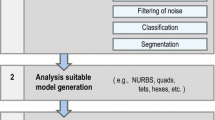Abstract
Object Conversion of thoracic aortic vasculature as measured by Magnetic Resonance Imaging into a real physical replica. Materials and methods Several procedural steps including data acquisition with contrast enhanced MR Angiography at 3T, data visualization and 3D computer model generation, as well as rapid prototyping were used to construct an in-vitro model of the vessel geometry. Results A rapid vessel prototyping process was implemented and used to convert complex vascular geometry of the entire thoracic aorta and major branching arteries into a real physical replica with large anatomical coverage and high spatial resolution. Conclusion Rapid vessel prototyping permits the creation of a concrete solid replica of a patient’s vascular anatomy
Similar content being viewed by others

References
Chong CK, Rowe CS, Sivanesan S, et al. (1999) Computer aided design and fabrication of models for in vitro studies of vascular fluid dynamics. Proc Inst Mech Eng [H]. 213:1–4
D’Urso PS, Thompson RG, Atkinson RL, Weidmann MJ, Redmond MJ, Hall BI, Jeavons SJ, Benson MD, Earwaker WJ (1999) Cerebrovascular biomodelling: a technical note. Surg Neurol. 52:490–500
Barker TM, Earwaker WJ, Frost N, Wakeley G (1993) Integration of 3-D medical imaging and rapid prototyping to create stereolithographic models. Aust Phys Eng Sci 16(2):79–85
Prince MR (1994) Gadolinium-enhanced MR aortography. Radiology 191(1):155–164
Prince MR, Narasimham DL, Stanley JC, Wakefield TW, Messina LM, Zelenock GB, Jacoby WT, Marx MV, Williams DM, Cho KJ (1995) Gadolinium-enhanced magnetic resonance angiography of abdominal aortic aneurysms. J Vasc Surg 21(4):656–669
Frangi AF, Niessen WJ, Nederkoorn PJ, Bakker J, Mali WP, Viergever MA (2001) Quantitative analysis of vascular morphology from 3D MR angiograms: in vitro and in vivo results. Magn Reson Med 45(2):311–322
Yang PC, Nguyen P, Shimakawa A, Brittain J, Pauly J, Nishimura D, Hu B, McConnell M (2004) Spiral magnetic resonance coronary angiography – direct comparison of 1.5 Tesla vs. 3 Tesla. J Cardiovasc Magn Reson 6(4):877–884
Markl M, Chan FP, Alley MT, Wedding KL, Draney MT, Elkins CJ, Parker DW, Wicker R, Taylor CA, Herfkens RJ, Pelc NJ (2003) Time-resolved three-dimensional phase-contrast MRI. J Magn Reson Imaging 17(4):499–506
Elkins CJ, Markl M, Pelc N, Eaton JK (2003) 4D Magnetic resonance velocimetry for mean velocity measurements in complex turbulent flows. Exp Fluids 2003;34(4):494–503
Pruessmann KP (2004) Parallel imaging at high field strength: synergies and joint potential. Top Magn Reson Imaging 15(4):237–244
Kato K, Ishiguchi T, Maruyama K, Naganawa S, Ishigaki T (2001) Accuracy of plastic replica of aortic aneurysm using 3D-CT data for transluminal stent-grafting: experimental and clinical evaluation. J Comput Assist Tomogr 25(2):300–304
Knox K, Kerber CW, Singel SA, Bailey MJ, Imbesi SG (2005) Stereolithographic vascular replicas from CT scans: choosing treatment strategies, teaching, and research from live patient scan data. AJNR Am J Neuroradiol 26(6):1428–1431
Tateshima S, Murayama Y, Villablanca JP, Morino T, Takahashi H, Yamauchi T, Tanishita K, Vinuela F (2001) Intraaneurysmal flow dynamics study featuring an acrylic aneurysm model manufactured using a computerized tomography angiogram as a mold. J Neurosurg 95(6):1020–1027
Norris DG (2003) High field human imaging. J Magn Reson Imaging 18(5):519–529
Trattnig S, Ba-Ssalamah A, Noebauer-Huhmann IM, Barth M, Wolfsberger S, Pinker K, Knosp E (2003) MR contrast agent at high-field MRI (3 Tesla). Top Magn Reson Imaging 14(5):365–375
Pruessmann KP, Weiger M, Scheidegger MB, Boesiger P (1999) SENSE: sensitivity encoding for fast MRI. Magn Reson Med 42(5):952–962
Griswold MA, Jakob PM, Heidemann RM, Nittka M, Jellus V, Wang J, Kiefer B, Haase A (2002) Generalized autocalibrating partially parallel acquisitions (GRAPPA). Magn Reson Med 47(6):1202–1210
Author information
Authors and Affiliations
Corresponding author
Additional information
Parts of this work were presented at the ESMRMB 2005
Rights and permissions
About this article
Cite this article
Markl, M., Schumacher, R., Küffer, J. et al. Rapid vessel prototyping: vascular modeling using 3t magnetic resonance angiography and rapid prototyping technology. MAGMA 18, 288–292 (2005). https://doi.org/10.1007/s10334-005-0019-6
Received:
Accepted:
Published:
Issue Date:
DOI: https://doi.org/10.1007/s10334-005-0019-6



